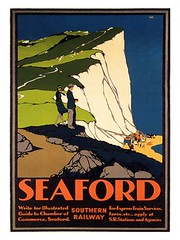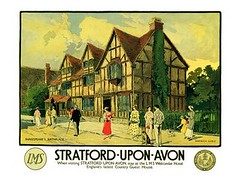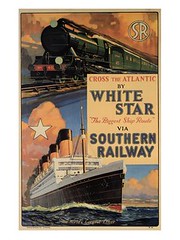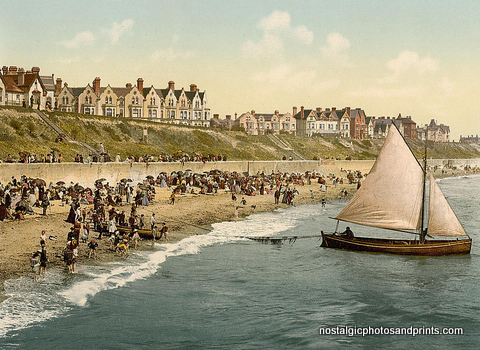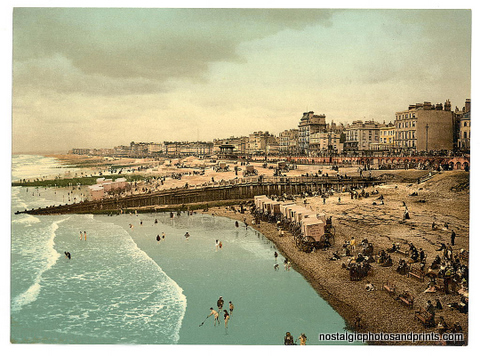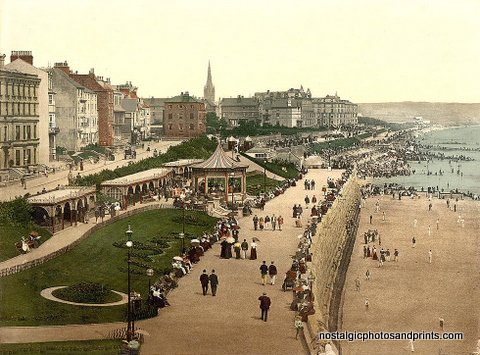Thursday 8 April 2010
sunny south sam rail travel poster 1930s
Seaford southern railway
Friday 19 March 2010
south for winter sunshine southern railway travel poster
south for winter sunshine southern railway travel poster vaughan 1929
Art Deco British Railway travel poster

Art Deco British Railway travel poster

stratford upon avon
Saturday 6 March 2010
speed to the west charles mayo railway poster 1939
speed to the west charles mayo railway poster 1939-Cornwall,Devon,Somerset,Wales-GWR, Great Western Railway.


sunny south sam southern poster 1939
sunny south sam southern poster 1939,"Why do they call me southern sam?" Because "the sun shines more on the southern coast."
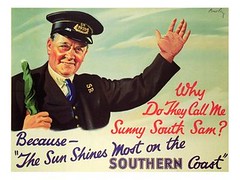

Wednesday 3 March 2010
White star and southern railway
Vintage visit Brighton poster
Monday 18 January 2010
Ingoldmells
Ingoldmells, High Street c1965
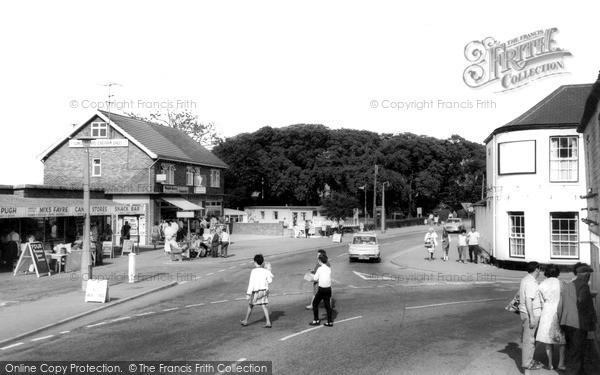
Reproduced courtesy of Francis Frith.
Ingoldmells, Post Office Stores c1955
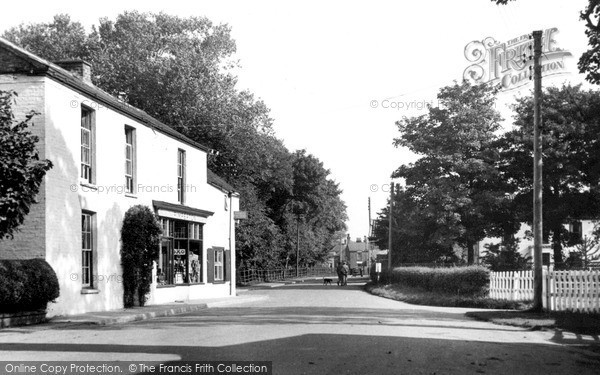
Reproduced courtesy of Francis Frith.
Ingoldmells, Butlin's Holiday Camp c1955
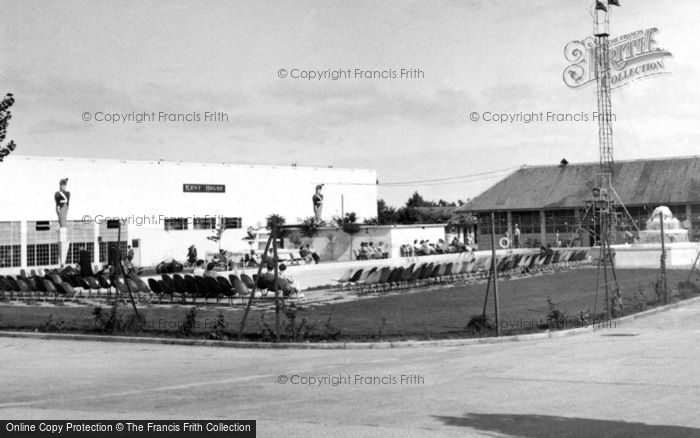
Reproduced courtesy of Francis Frith.
In terms of villages it is relatively large and it has a population of 3888. The village receives a lot of tourism yearly due its close position to Skegness. Most housing is found in the west of the village in large council complexes near the beautiful ancient church of St Peter and Paul. The primary school is on Simpson Court.
Close by to the west is Addlethorpe. There are fish and chip shops near the beach.
History
During World War II, RAF Ingoldmells was a Chain Home Low radar station, providing low-altitude short-range warning, with a rotating antenna. RAF Stenigot on the Lincolnshire Wolds provided longer-range warning for the area. RAF Skendleby was the other Chain Home Low station in Lincolnshire near Skendleby, Spilsby.
Holiday parks
Billy Butlin opened the UK's first holiday camp there in 1936, which is a large employer in the area, and attracts many tourists. During World War II the Butlin's camp was used as the site of HMS Royal Arthur, a Royal Navy shore establishment.
Fantasy Island
Fantasy Island is a family Amusement Park in Ingoldmells. The park opened in 1995 and has since built up a wide variety of rides, attractions and entertainment. Whilst entry to the park is free, guests either pay per ride or purchase an unlimited ride wristband. There is a large open air market situated within the park, as well as an indoor market.
Many facilities have become available to accommodate the tourists including some shops and caravan parks.
http://en.wikipedia.org/wiki/Ingoldmells

Reproduced courtesy of Francis Frith.
Ingoldmells, Post Office Stores c1955

Reproduced courtesy of Francis Frith.
Ingoldmells, Butlin's Holiday Camp c1955

Reproduced courtesy of Francis Frith.
In terms of villages it is relatively large and it has a population of 3888. The village receives a lot of tourism yearly due its close position to Skegness. Most housing is found in the west of the village in large council complexes near the beautiful ancient church of St Peter and Paul. The primary school is on Simpson Court.
Close by to the west is Addlethorpe. There are fish and chip shops near the beach.
History
During World War II, RAF Ingoldmells was a Chain Home Low radar station, providing low-altitude short-range warning, with a rotating antenna. RAF Stenigot on the Lincolnshire Wolds provided longer-range warning for the area. RAF Skendleby was the other Chain Home Low station in Lincolnshire near Skendleby, Spilsby.
Holiday parks
Billy Butlin opened the UK's first holiday camp there in 1936, which is a large employer in the area, and attracts many tourists. During World War II the Butlin's camp was used as the site of HMS Royal Arthur, a Royal Navy shore establishment.
Fantasy Island
Fantasy Island is a family Amusement Park in Ingoldmells. The park opened in 1995 and has since built up a wide variety of rides, attractions and entertainment. Whilst entry to the park is free, guests either pay per ride or purchase an unlimited ride wristband. There is a large open air market situated within the park, as well as an indoor market.
Many facilities have become available to accommodate the tourists including some shops and caravan parks.
http://en.wikipedia.org/wiki/Ingoldmells
Thursday 14 January 2010
Chapel St Leonards
Chapel St Leonards, the Vine Hotel 1959

Reproduced courtesy of Francis Frith.
Chapel St Leonards, the Village c1959
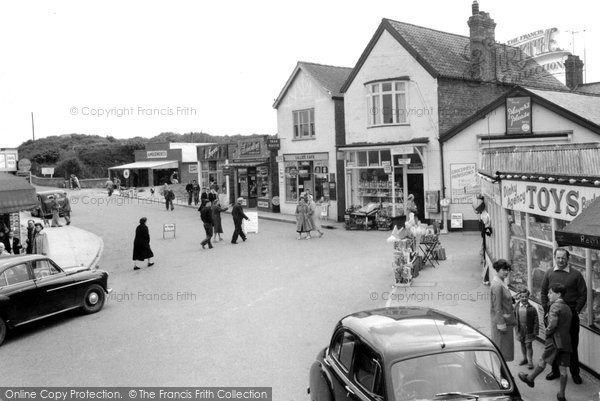
Reproduced courtesy of Francis Frith.
Chapel St Leonards
Chapel St. Leonards is a village in Lincolnshire on the east coast of England and is situated just 5 miles to the north of the resort of Skegness. It is administered by East Lindsey District Council.
The village is primary a location for caravan park holidays, with its main attraction being several miles of beaches.
The village is close to the many attractions this region has to offer, including Fantasy Island, market towns, and the Lincolnshire Wolds.
Another feature of the village is Chapel Point, which is a mile north of the centre of the village. Chapel Point was once part of a major coastal defence line during World War II and has now been restored. The restoration has included the Gun Structure and the Viewing Platform. In recent years, it has become a favourite location for birdwatchers, as it is frequently visited by a number of overseas birds such as the Mediterranean Gull.
History
The name of the village derives from the fact that there was originally a chapel of Mumby dedicated to St Leonard here, the parish history being tied very closely to Mumby parish and Mumby Chapel as, at one time, they were all part of one large ecclesiastical entity.
The chapel was rebuilt in 1572 after a flood and it was again rebuilt in 1794 on a much smaller scale. There was further rebuilding in 1866 and in 1901 the church was lengthened and the tower built. The red tiled tower is unique in Lincolnshire.
In 1924, the chapel was enlarged and lengthened with a new east window and reredos. As it stands, the present Anglican parish church only has registers that date from 1665, although Bishop's transcripts go back as far as 1568.
http://en.wikipedia.org/wiki/Chapel_St_Leonards

Reproduced courtesy of Francis Frith.
Chapel St Leonards, the Village c1959

Reproduced courtesy of Francis Frith.
Chapel St Leonards
Chapel St. Leonards is a village in Lincolnshire on the east coast of England and is situated just 5 miles to the north of the resort of Skegness. It is administered by East Lindsey District Council.
The village is primary a location for caravan park holidays, with its main attraction being several miles of beaches.
The village is close to the many attractions this region has to offer, including Fantasy Island, market towns, and the Lincolnshire Wolds.
Another feature of the village is Chapel Point, which is a mile north of the centre of the village. Chapel Point was once part of a major coastal defence line during World War II and has now been restored. The restoration has included the Gun Structure and the Viewing Platform. In recent years, it has become a favourite location for birdwatchers, as it is frequently visited by a number of overseas birds such as the Mediterranean Gull.
History
The name of the village derives from the fact that there was originally a chapel of Mumby dedicated to St Leonard here, the parish history being tied very closely to Mumby parish and Mumby Chapel as, at one time, they were all part of one large ecclesiastical entity.
The chapel was rebuilt in 1572 after a flood and it was again rebuilt in 1794 on a much smaller scale. There was further rebuilding in 1866 and in 1901 the church was lengthened and the tower built. The red tiled tower is unique in Lincolnshire.
In 1924, the chapel was enlarged and lengthened with a new east window and reredos. As it stands, the present Anglican parish church only has registers that date from 1665, although Bishop's transcripts go back as far as 1568.
http://en.wikipedia.org/wiki/Chapel_St_Leonards
Wednesday 13 January 2010
skegness
Skegness, Official Opening of the Clock Tower 1899
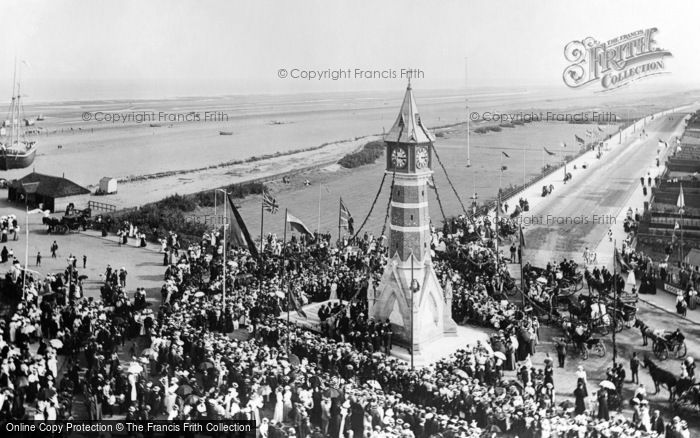
Reproduced courtesy of Francis Frith.
Skegness, the Clock Tower c1955
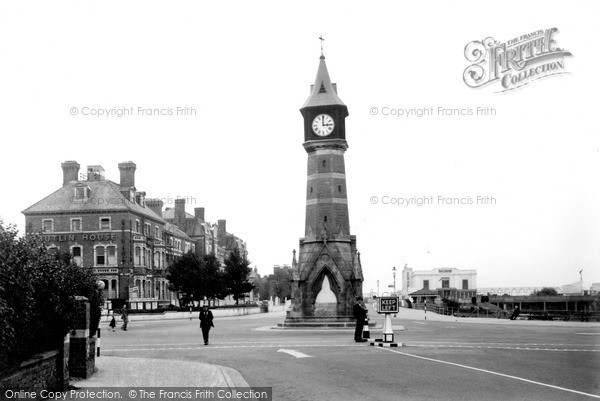
Reproduced courtesy of Francis Frith.
Early history
The name indicates that Skegness has its origin in the Danish period of settlement in England. Local historians say that the town took its name from Skeggi (meaning 'bearded one'), one of the Vikings who established the original settlement which has since been washed away by the sea. However, it is much more likely to have derived from words which appear in modern Danish as skæg, beard and næs, nose or in geographical terms, headland.
Lying within the historic county boundaries of Lincolnshire from a very early time, for governance, the parish of Skegness was in the Marsh division of the ancient Candleshoe Wapentake in the Parts of Lindsey.
Longshore drift carries particles of sediment southwards along the Lincolnshire coast but at Skegness, the sand settles out in banks (tombolos) which run at a slight angle to the coast forming the beard. The slightly elevated dune land sheltered the small natural harbour which the Danes found behind the banks. The finer sediment drifts on to find a home in the mud of The Wash, beyond Gibraltar Point.
In August 1642, a consignment of arms and money, probably raised by Queen Henrietta Maria, in the Netherlands for the support of King Charles I's campaign in the Civil War, was forced into Skegness by the ships of the Parliamentarian Earl of Warwick.
Skegness was primarily a fishing village and small port until the arrival of the railway in 1875. In 1908, Great Northern Railways commissioned a poster to advertise excursions to the resort, the first being from King's Cross, London on Good Friday 1908, leaving London at 11.30 am. The 'Skegness is so Bracing' poster featuring The Jolly Fisherman helped to put Skegness on the map and is now world famous. The poster, derived from an oil painting by John Hassall (illustrator), was purchased by the railway company for the 12 guineas. Paradoxically, Mr Hassall did not visit the resort until 1936. He is said to have died penniless.
Resort town and Butlins
Most of the land in what is now the downtown core formed part of the estate of the Earl of Scarbrough and he, together with his agent H.V.Tippet, realised that the extensive sandy beach could be made attractive to holidaymakers from the industrial towns of the English Midlands, a clientele already developed by Thomas Cook. He planned the town as a resort from 1877 and it expanded rapidly, but along with many other UK resorts, especially those on the cold North Sea, it lost out to the cheap package holiday boom which opened up Spain (in particular) to the average holidaymaker after World War II currency restrictions were lifted and travellers could leave the UK with more than 50 pounds.
Ingoldmells, the parish to the north of Skegness, was the site of the UK's first Holiday Camp, started by Billy Butlin in 1936. Butlins is still there today, in modern dress, at the north end of the town, on the road to Ingoldmells. It maintains its appeal as a popular destination for family holidays, and attracts thousands to the resort in the low season with music weekends encompassing 60s, 80s, soul and other genres.
The Wash Incident
The Wash Incident took place in the early hours of 5 October 1996 when a strange red and green rotating light was seen by many Skegness residents and police officers to the southeast of Skegness, who then contacted the Coastguard at Great Yarmouth. It later involved many RAF stations, including RAF Neatishead, and GCHQ. The object was not an aircraft because although it could be seen on radar, it had no transponder. The Skegness News, a local newspaper which no longer exists, investigated the incident and sought confirmation of the object from the Jodrell Bank Observatory. In their report to the RAF, the observatory said that Venus, ‘the queen of UFOs’, which had been shining with exceptional brilliance in the early morning sky to the east, probably explained the light shown on the video.
Present day
In March 2005, Skegness took the top spot in a survey by "Yours magazine", looking at the best retirement places in the UK. Yours researchers visited sixty likely towns, and factors involved in judging included house prices, hospital waiting lists, the crime rate, council tax rates, activities and attractions, weather patterns and ease of transport. It has also been described by Lonely Planet's Great Britain guide as "everything you could want" in a seaside resort. On 22 July 2008 the newly elected Mayor of London, Boris Johnson, caused controversy in an article in the Daily Telegraph where he declared "Stuff Skegness, my trunks and I are off to the sun" in his desire to have a foreign holiday this year.
http://en.wikipedia.org/wiki/Skegness

Reproduced courtesy of Francis Frith.
Skegness, the Clock Tower c1955

Reproduced courtesy of Francis Frith.
Early history
The name indicates that Skegness has its origin in the Danish period of settlement in England. Local historians say that the town took its name from Skeggi (meaning 'bearded one'), one of the Vikings who established the original settlement which has since been washed away by the sea. However, it is much more likely to have derived from words which appear in modern Danish as skæg, beard and næs, nose or in geographical terms, headland.
Lying within the historic county boundaries of Lincolnshire from a very early time, for governance, the parish of Skegness was in the Marsh division of the ancient Candleshoe Wapentake in the Parts of Lindsey.
Longshore drift carries particles of sediment southwards along the Lincolnshire coast but at Skegness, the sand settles out in banks (tombolos) which run at a slight angle to the coast forming the beard. The slightly elevated dune land sheltered the small natural harbour which the Danes found behind the banks. The finer sediment drifts on to find a home in the mud of The Wash, beyond Gibraltar Point.
In August 1642, a consignment of arms and money, probably raised by Queen Henrietta Maria, in the Netherlands for the support of King Charles I's campaign in the Civil War, was forced into Skegness by the ships of the Parliamentarian Earl of Warwick.
Skegness was primarily a fishing village and small port until the arrival of the railway in 1875. In 1908, Great Northern Railways commissioned a poster to advertise excursions to the resort, the first being from King's Cross, London on Good Friday 1908, leaving London at 11.30 am. The 'Skegness is so Bracing' poster featuring The Jolly Fisherman helped to put Skegness on the map and is now world famous. The poster, derived from an oil painting by John Hassall (illustrator), was purchased by the railway company for the 12 guineas. Paradoxically, Mr Hassall did not visit the resort until 1936. He is said to have died penniless.
Resort town and Butlins
Most of the land in what is now the downtown core formed part of the estate of the Earl of Scarbrough and he, together with his agent H.V.Tippet, realised that the extensive sandy beach could be made attractive to holidaymakers from the industrial towns of the English Midlands, a clientele already developed by Thomas Cook. He planned the town as a resort from 1877 and it expanded rapidly, but along with many other UK resorts, especially those on the cold North Sea, it lost out to the cheap package holiday boom which opened up Spain (in particular) to the average holidaymaker after World War II currency restrictions were lifted and travellers could leave the UK with more than 50 pounds.
Ingoldmells, the parish to the north of Skegness, was the site of the UK's first Holiday Camp, started by Billy Butlin in 1936. Butlins is still there today, in modern dress, at the north end of the town, on the road to Ingoldmells. It maintains its appeal as a popular destination for family holidays, and attracts thousands to the resort in the low season with music weekends encompassing 60s, 80s, soul and other genres.
The Wash Incident
The Wash Incident took place in the early hours of 5 October 1996 when a strange red and green rotating light was seen by many Skegness residents and police officers to the southeast of Skegness, who then contacted the Coastguard at Great Yarmouth. It later involved many RAF stations, including RAF Neatishead, and GCHQ. The object was not an aircraft because although it could be seen on radar, it had no transponder. The Skegness News, a local newspaper which no longer exists, investigated the incident and sought confirmation of the object from the Jodrell Bank Observatory. In their report to the RAF, the observatory said that Venus, ‘the queen of UFOs’, which had been shining with exceptional brilliance in the early morning sky to the east, probably explained the light shown on the video.
Present day
In March 2005, Skegness took the top spot in a survey by "Yours magazine", looking at the best retirement places in the UK. Yours researchers visited sixty likely towns, and factors involved in judging included house prices, hospital waiting lists, the crime rate, council tax rates, activities and attractions, weather patterns and ease of transport. It has also been described by Lonely Planet's Great Britain guide as "everything you could want" in a seaside resort. On 22 July 2008 the newly elected Mayor of London, Boris Johnson, caused controversy in an article in the Daily Telegraph where he declared "Stuff Skegness, my trunks and I are off to the sun" in his desire to have a foreign holiday this year.
http://en.wikipedia.org/wiki/Skegness
Sunday 27 December 2009
Clackton
Brighton
Bridlington
Monday 21 December 2009
Bournemouth
Bournemouth

Bournemouth is a large coastal resort town in the Borough of Bournemouth, England. The town has a population of 163,444 according to the 2001 Census, making it the largest settlement in Dorset. It is also the largest settlement between Southampton and Plymouth. With Poole and Christchurch it forms the South East Dorset conurbation, which has a total population of approximately 400,000.
Founded in 1810 by Lewis Tregonwell, Bournemouth's growth accelerated with the arrival of the railway, becoming a recognised town in 1870. Originally part of Hampshire, it joined Dorset with the reorganisation of local government in 1974. Since 1997 the town has been administered by a unitary authority, meaning that it has autonomy from Dorset County Council.
Bournemouth's location on the south coast of England has made it a popular destination for tourists. The town is a regional centre of business, home of the Bournemouth International Centre and financial companies that include: Liverpool Victoria and Standard Life Healthcare.
In a 2007 survey by First Direct Bank, Bournemouth was found to be the happiest place in Britain with 82% of people questioned saying they were happy with their life
With the exception of the estate, until 1802 most of the Bournemouth area was common land. The Christchurch Inclosures Act 1802 and the Inclosure Commissioners' Award of 1805 transferred hundreds of acres into private ownership for the first time. In 1809, the Tapps Arms public house appeared on the heath. A few years later, in 1812, the first residents, retired army officer Lewis Tregonwell and his wife, moved into their new home built on land he had purchased from Sir George Ivison Tapps. Tregonwell began developing his land for holiday letting by building a series of sea villas. In association with Tapps, he planted hundreds of Pine trees, providing a sheltered walk to the beach (later to become known as the 'Invalids walk'). The town would ultimately grow up around its scattered pines. In 1832 when Tregonwell died, Bournemouth had grown into small community with a scattering of houses, villas and cottages.
Bournemouth Town Hall was built in the Victorian period, originally serving as a hotel for visitors to the town.In 1835, after the death of Sir George Ivison Tapps, his son Sir George William Tapps-Gervis inherited his father's estate. Bournemouth started to grow at a faster rate as George William started developing the seaside village into a resort similar to those that had already grown up along the south coast such as Weymouth and Brighton. In 1841, the town was visited by the physician and writer Augustus Granville. Granville was the author of The Spas of England, which described health resorts around the country. As a result of his visit, Dr Granville included a chapter on Bournemouth in the second edition of his book. The publication of the book, as well as the growth of visitors to the seaside seeking the medicinal use of the seawater and the fresh air of the pines, helped the town to grow and establish itself as an early tourist destination.
In the 1840s the fields south of the road crossing (later Bournemouth Square) were drained and laid out with shrubberies and walks. Many of these paths including the 'Invalids walk' remain in the town today; forming part of the Pleasure Gardens which extend for several miles along the Bourne stream. The Pleasure Gardens were originally a series of garden walks created in the fields of the owners of the Branksome Estate in the 1860s. In the early 1870s all the fields were leased to the Bournemouth Commissioners by the freeholders. Parliament approved the Bournemouth Improvement Act in 1856. Under the Act, a board of 13 Commissioners was established to build and organise the expanding infrastructure of the town, such as paving, sewers, drainage, street lighting and street cleaning.
During the late 19th century the town continued to develop. The Winter Gardens were finished in 1875 and the cast iron Bournemouth pier was finished in 1880. The arrival of the railways allowed a massive growth of seaside and summer visits to the town, especially by visitors from the Midlands and London. In 1880 the town had a population of 17,000 people but by 1900, when railway connections were at their most developed to Bournemouth, the town's population had risen to 60,000. It was also during this period that the town became a favourite location for visiting artists and writers. The town was improved greatly during this period through the efforts of Sir Merton Russell-Cotes, the town's Mayor and a local philanthropist. He helped establish the town's first library and museum. The Russell-Cotes Art Gallery & Museum was housed in his mansion and after his death it was given to the town.
As Bournemouth's growth increased in the early 20th century, the town centre spawned theatres, cafés, two art deco cinemas and more hotels. Other new buildings included the War Memorial in 1921 and the Bournemouth Pavilion, the towns concert hall and grand theatre finished in 1925. The town escaped great damage during the Second World War but saw a period of decline as a seaside resort in the post war era.
In 1985, Bournemouth became the first town in the United Kingdom to introduce and use CCTV cameras for public street-based surveillance.
http://en.wikipedia.org/wiki/Bournemouth

Bournemouth is a large coastal resort town in the Borough of Bournemouth, England. The town has a population of 163,444 according to the 2001 Census, making it the largest settlement in Dorset. It is also the largest settlement between Southampton and Plymouth. With Poole and Christchurch it forms the South East Dorset conurbation, which has a total population of approximately 400,000.
Founded in 1810 by Lewis Tregonwell, Bournemouth's growth accelerated with the arrival of the railway, becoming a recognised town in 1870. Originally part of Hampshire, it joined Dorset with the reorganisation of local government in 1974. Since 1997 the town has been administered by a unitary authority, meaning that it has autonomy from Dorset County Council.
Bournemouth's location on the south coast of England has made it a popular destination for tourists. The town is a regional centre of business, home of the Bournemouth International Centre and financial companies that include: Liverpool Victoria and Standard Life Healthcare.
In a 2007 survey by First Direct Bank, Bournemouth was found to be the happiest place in Britain with 82% of people questioned saying they were happy with their life
With the exception of the estate, until 1802 most of the Bournemouth area was common land. The Christchurch Inclosures Act 1802 and the Inclosure Commissioners' Award of 1805 transferred hundreds of acres into private ownership for the first time. In 1809, the Tapps Arms public house appeared on the heath. A few years later, in 1812, the first residents, retired army officer Lewis Tregonwell and his wife, moved into their new home built on land he had purchased from Sir George Ivison Tapps. Tregonwell began developing his land for holiday letting by building a series of sea villas. In association with Tapps, he planted hundreds of Pine trees, providing a sheltered walk to the beach (later to become known as the 'Invalids walk'). The town would ultimately grow up around its scattered pines. In 1832 when Tregonwell died, Bournemouth had grown into small community with a scattering of houses, villas and cottages.
Bournemouth Town Hall was built in the Victorian period, originally serving as a hotel for visitors to the town.In 1835, after the death of Sir George Ivison Tapps, his son Sir George William Tapps-Gervis inherited his father's estate. Bournemouth started to grow at a faster rate as George William started developing the seaside village into a resort similar to those that had already grown up along the south coast such as Weymouth and Brighton. In 1841, the town was visited by the physician and writer Augustus Granville. Granville was the author of The Spas of England, which described health resorts around the country. As a result of his visit, Dr Granville included a chapter on Bournemouth in the second edition of his book. The publication of the book, as well as the growth of visitors to the seaside seeking the medicinal use of the seawater and the fresh air of the pines, helped the town to grow and establish itself as an early tourist destination.
In the 1840s the fields south of the road crossing (later Bournemouth Square) were drained and laid out with shrubberies and walks. Many of these paths including the 'Invalids walk' remain in the town today; forming part of the Pleasure Gardens which extend for several miles along the Bourne stream. The Pleasure Gardens were originally a series of garden walks created in the fields of the owners of the Branksome Estate in the 1860s. In the early 1870s all the fields were leased to the Bournemouth Commissioners by the freeholders. Parliament approved the Bournemouth Improvement Act in 1856. Under the Act, a board of 13 Commissioners was established to build and organise the expanding infrastructure of the town, such as paving, sewers, drainage, street lighting and street cleaning.
During the late 19th century the town continued to develop. The Winter Gardens were finished in 1875 and the cast iron Bournemouth pier was finished in 1880. The arrival of the railways allowed a massive growth of seaside and summer visits to the town, especially by visitors from the Midlands and London. In 1880 the town had a population of 17,000 people but by 1900, when railway connections were at their most developed to Bournemouth, the town's population had risen to 60,000. It was also during this period that the town became a favourite location for visiting artists and writers. The town was improved greatly during this period through the efforts of Sir Merton Russell-Cotes, the town's Mayor and a local philanthropist. He helped establish the town's first library and museum. The Russell-Cotes Art Gallery & Museum was housed in his mansion and after his death it was given to the town.
As Bournemouth's growth increased in the early 20th century, the town centre spawned theatres, cafés, two art deco cinemas and more hotels. Other new buildings included the War Memorial in 1921 and the Bournemouth Pavilion, the towns concert hall and grand theatre finished in 1925. The town escaped great damage during the Second World War but saw a period of decline as a seaside resort in the post war era.
In 1985, Bournemouth became the first town in the United Kingdom to introduce and use CCTV cameras for public street-based surveillance.
http://en.wikipedia.org/wiki/Bournemouth
Bognor Regis
Bognor Regis
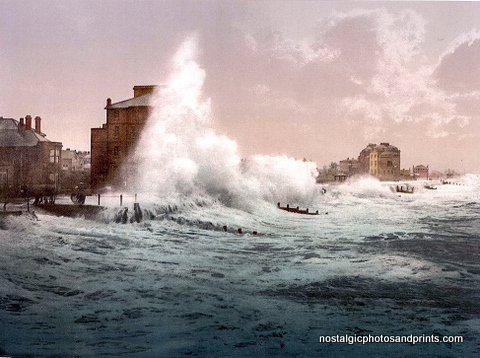
Bognor Regis is a seaside resort town and civil parish in the Arun District of West Sussex, on the south coast of England. It lies 55.5 miles (89 km) south southwest of London, 24 miles (39 km) west of Brighton, and 6 miles (10 km) southeast of the county town of Chichester. Other nearby towns include Littlehampton east northeast and Selsey to the southwest. The nearby villages of Felpham, briefly home to the poet William Blake, and Aldwick are now suburbs of Bognor Regis, along with those of North and South Bersted.
Bognor Regis was originally named just "Bognor", being a fishing (and one time, smuggling) village until the 18th century, when it was converted into a resort by Sir Richard Hotham. Tourism gradually took off over the next hundred years, the area being chosen as an ideal location for King George V to convalesce in during 1929, the King and Queen actually staying at Craigwell House Aldwick; as a result, the King was asked to bestow the "Regis" ("of the King") suffix on "Bognor".
Legend has it that the King's last words, upon being told that he would soon be well enough to revisit the town, were "Bugger Bognor!" Although there is little evidence that these words were actually uttered in this context, and although the sea air helped the King to regain his health, it is certain that the King had little regard (to put it mildly) for the town.
Bognor was a part of the ancient parish of South Bersted in the county of Sussex, attaining parish status separate from South Bersted in 1828. Until 1894 it formed part of the Hundred of Aldwick, an ancient division of Chichester Rape. From 1894 to 1974 it was part of Bognor Urban District (Bognor Regis Urban District from 1929), and since 1974 it has been a part of Arun District.
The historic meeting of the crews (and associated handshake) of the Apollo-Soyuz Test Project on 17 July 1975 was supposed to have taken place over Bognor Regis, but a flight delay caused it to occur over Metz in France instead.
Bognor Regis town centre was damaged in 1994 by an IRA device left in a bicycle outside woolworths. 15 shops were damaged but no injuries occurred.
On the beach between Bognor Regis and Aldwick lies the wreck of a Floating Pontoon. It is part of the Mulberry Harbour which was towed across to Normandy on D-Day June 6, 1944. This particular section of Mulberry didn't make it across the channel and was washed up on the beach shortly after D-Day. It is clearly visible at low tide throughout the year.
http://en.wikipedia.org/wiki/Bognor_Regis

Bognor Regis is a seaside resort town and civil parish in the Arun District of West Sussex, on the south coast of England. It lies 55.5 miles (89 km) south southwest of London, 24 miles (39 km) west of Brighton, and 6 miles (10 km) southeast of the county town of Chichester. Other nearby towns include Littlehampton east northeast and Selsey to the southwest. The nearby villages of Felpham, briefly home to the poet William Blake, and Aldwick are now suburbs of Bognor Regis, along with those of North and South Bersted.
Bognor Regis was originally named just "Bognor", being a fishing (and one time, smuggling) village until the 18th century, when it was converted into a resort by Sir Richard Hotham. Tourism gradually took off over the next hundred years, the area being chosen as an ideal location for King George V to convalesce in during 1929, the King and Queen actually staying at Craigwell House Aldwick; as a result, the King was asked to bestow the "Regis" ("of the King") suffix on "Bognor".
Legend has it that the King's last words, upon being told that he would soon be well enough to revisit the town, were "Bugger Bognor!" Although there is little evidence that these words were actually uttered in this context, and although the sea air helped the King to regain his health, it is certain that the King had little regard (to put it mildly) for the town.
Bognor was a part of the ancient parish of South Bersted in the county of Sussex, attaining parish status separate from South Bersted in 1828. Until 1894 it formed part of the Hundred of Aldwick, an ancient division of Chichester Rape. From 1894 to 1974 it was part of Bognor Urban District (Bognor Regis Urban District from 1929), and since 1974 it has been a part of Arun District.
The historic meeting of the crews (and associated handshake) of the Apollo-Soyuz Test Project on 17 July 1975 was supposed to have taken place over Bognor Regis, but a flight delay caused it to occur over Metz in France instead.
Bognor Regis town centre was damaged in 1994 by an IRA device left in a bicycle outside woolworths. 15 shops were damaged but no injuries occurred.
On the beach between Bognor Regis and Aldwick lies the wreck of a Floating Pontoon. It is part of the Mulberry Harbour which was towed across to Normandy on D-Day June 6, 1944. This particular section of Mulberry didn't make it across the channel and was washed up on the beach shortly after D-Day. It is clearly visible at low tide throughout the year.
http://en.wikipedia.org/wiki/Bognor_Regis
Blackpool
Blackpool
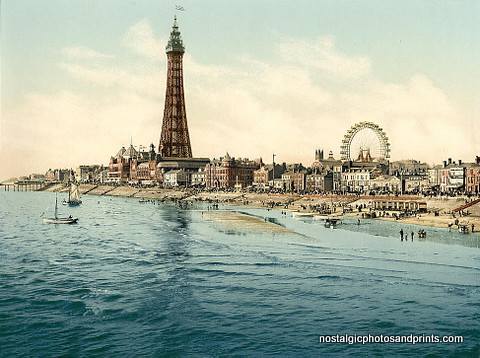

Blackpool is a seaside town in Lancashire, England. Situated along the coast of the Irish Sea, it has a population of 142,900, making it the fourth-largest settlement in North West England behind Manchester, Liverpool and Warrington.
It lies 40 miles (64 km) north-west of the city of Manchester, and less than 30 miles north of Liverpool City centre. Blackpool is the fourth most densely populated local authority district of England & Wales outside Greater London.
Blackpool rose to prominence as a major centre of tourism during the 19th century, particularly for the inhabitants of northern mill towns.
By the middle of the 18th century, the practice of sea bathing to cure diseases was beginning to become fashionable among the wealthier classes, and visitors began making the arduous trek to Blackpool for that purpose. In 1781 Thomas Clifton and Sir Henry Hoghton built a private road to Blackpool, and a regular stagecoach service from Manchester and Halifax was established. A few amenities, including four hotels, an archery stall and bowling greens, were developed, and the town grew slowly. The 1801 census records the town's population at 473. The growth was accelerated by the actions of Henry Banks, often considered to be the “Father of Blackpool”. In 1819 he purchased the Lane Ends estate, including the Lane Ends Hotel and built the first holiday cottages. In 1837, his son-in-law Dr. John Cocker built Blackpool’s first assembly rooms, which still stand on the corner of Victoria Street and Bank Hey Street.
Arrival of the railways
The most significant event in the early growth of the town occurred in 1846, with the completion of a branch line to Blackpool from Poulton on the main Preston and Wyre Joint Railway line from Preston to Fleetwood. Fleetwood declined as a resort, as its founder and principal financial backer, Peter Hesketh-Fleetwood went bankrupt. In contrast, Blackpool boomed. A sudden influx of visitors, arriving by rail, provided the motivation for entrepreneurs to build accommodations and create new attractions, leading to more visitors and a rapid cycle of growth throughout the 1850s and 1860s. In 1851 a Board of Health was formed. Gas lighting was introduced in 1852, and piped water in 1864. By 1851, the town's population was over 2500.
The growth was intensified by the practice among the Lancashire cotton mill owners to close the factories for a week every year to service and repair machinery. These became known as wakes weeks. Each town's mills would close for a different week, allowing Blackpool to manage a steady and reliable stream of visitors over a prolonged period in the summer.
In 1863, the North Pier was completed, rapidly becoming a centre of attraction for elite visitors. Central Pier was completed in 1868, with a theatre and a large open-air dance floor. The town expanded southward beyond what is today known as the Golden Mile, towards South Shore, and South Pier was completed in 1893, making Blackpool the only town in the United Kingdom with three piers. In 1878, the Winter Gardens complex opened, incorporating ten years later the Opera House, said to be the largest in Britain outside of London.
The town was granted a Charter of Incorporation as a municipal borough in 1876. W.H. Cocker, son of Dr John Cocker, and therefore grandson of Henry Banks, was its first mayor. The town would become a county borough in 1904.
http://en.wikipedia.org/wiki/Blackpool


Blackpool is a seaside town in Lancashire, England. Situated along the coast of the Irish Sea, it has a population of 142,900, making it the fourth-largest settlement in North West England behind Manchester, Liverpool and Warrington.
It lies 40 miles (64 km) north-west of the city of Manchester, and less than 30 miles north of Liverpool City centre. Blackpool is the fourth most densely populated local authority district of England & Wales outside Greater London.
Blackpool rose to prominence as a major centre of tourism during the 19th century, particularly for the inhabitants of northern mill towns.
By the middle of the 18th century, the practice of sea bathing to cure diseases was beginning to become fashionable among the wealthier classes, and visitors began making the arduous trek to Blackpool for that purpose. In 1781 Thomas Clifton and Sir Henry Hoghton built a private road to Blackpool, and a regular stagecoach service from Manchester and Halifax was established. A few amenities, including four hotels, an archery stall and bowling greens, were developed, and the town grew slowly. The 1801 census records the town's population at 473. The growth was accelerated by the actions of Henry Banks, often considered to be the “Father of Blackpool”. In 1819 he purchased the Lane Ends estate, including the Lane Ends Hotel and built the first holiday cottages. In 1837, his son-in-law Dr. John Cocker built Blackpool’s first assembly rooms, which still stand on the corner of Victoria Street and Bank Hey Street.
Arrival of the railways
The most significant event in the early growth of the town occurred in 1846, with the completion of a branch line to Blackpool from Poulton on the main Preston and Wyre Joint Railway line from Preston to Fleetwood. Fleetwood declined as a resort, as its founder and principal financial backer, Peter Hesketh-Fleetwood went bankrupt. In contrast, Blackpool boomed. A sudden influx of visitors, arriving by rail, provided the motivation for entrepreneurs to build accommodations and create new attractions, leading to more visitors and a rapid cycle of growth throughout the 1850s and 1860s. In 1851 a Board of Health was formed. Gas lighting was introduced in 1852, and piped water in 1864. By 1851, the town's population was over 2500.
The growth was intensified by the practice among the Lancashire cotton mill owners to close the factories for a week every year to service and repair machinery. These became known as wakes weeks. Each town's mills would close for a different week, allowing Blackpool to manage a steady and reliable stream of visitors over a prolonged period in the summer.
In 1863, the North Pier was completed, rapidly becoming a centre of attraction for elite visitors. Central Pier was completed in 1868, with a theatre and a large open-air dance floor. The town expanded southward beyond what is today known as the Golden Mile, towards South Shore, and South Pier was completed in 1893, making Blackpool the only town in the United Kingdom with three piers. In 1878, the Winter Gardens complex opened, incorporating ten years later the Opera House, said to be the largest in Britain outside of London.
The town was granted a Charter of Incorporation as a municipal borough in 1876. W.H. Cocker, son of Dr John Cocker, and therefore grandson of Henry Banks, was its first mayor. The town would become a county borough in 1904.
http://en.wikipedia.org/wiki/Blackpool
Saturday 19 December 2009
aberystwyth
aberystwyth
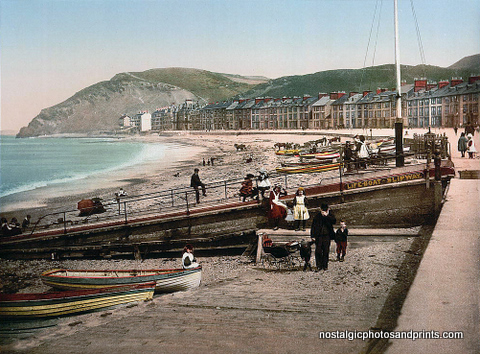
The Cambrian Railway line from Machynlleth reached Aberystwyth in the 1860s, closely followed by rail links to Carmarthen, which resulted in the construction of the town's impressive station. The railway's arrival gave rise to something of a Victorian tourist boom and the town was once even billed as the "Biarritz of Wales". During this time a number of hotels and fine townhouses were built including the Queens Hotel. One of the largest of these hotels "The Castle Hotel" was never completed as a hotel but following bankruptcy was sold cheaply to the Welsh National University Committee, a group of people dedicated to the creation of a Welsh University. The University College of Wales (later to become Aberystwyth University) was founded in 1872 in this building.
The National Library of Wales one of the main research and deposit libraries in the UKAberystwyth was a contributory parliamentary borough until the Third Reform Act, which caused its representation to be merged into that of the county in 1885.
Modern history
The Vale of Rheidol Railway narrow-gauge line from Devil's Bridge was constructed between 1901 and 1902, intended to ship mineral cargo, primarily lead, from Devil's Bridge down to Aberystwyth for trans-shipment. By the time it was finished, lead mining was in a deep downturn and it therefore came to rely largely on the tourist industry. The railway opened for passengers in December 1902. It is still open for the summer season today.
On the night of Friday 14 January 1938 a storm with estimated wind speeds of up to 90 mph (140 km/h) struck the town. Most of the promenade was destroyed, along with 200 feet (61 m) of the pier. Many properties on the seafront were damaged, most severely on Victoria Terrace.
Cymdeithas yr Iaith Gymraeg held their historic first protest on Trefechan Bridge in Aberystwyth, on 2 February 1963, and here also the first-ever independent Welsh Evangelical Church was established (see Evangelical Movement of Wales).
Merched y Wawr have their national headquarters in Aberystwyth.
Aberystwyth hosted the National Eisteddfod in 1865, 1916, 1952 and 1992.
On 1 March 2005 Aberystwyth was granted Fairtrade Town status.
In March 2009, mayor Sue Jones-Davies who had played the role of Judith Iscariot in the film Monty Python's Life of Brian organised a charity screening of the film with principal actors Terry Jones and Michael Palin attending. The town had earlier banned the film when it was released.
http://en.wikipedia.org/wiki/Aberystwyth

The Cambrian Railway line from Machynlleth reached Aberystwyth in the 1860s, closely followed by rail links to Carmarthen, which resulted in the construction of the town's impressive station. The railway's arrival gave rise to something of a Victorian tourist boom and the town was once even billed as the "Biarritz of Wales". During this time a number of hotels and fine townhouses were built including the Queens Hotel. One of the largest of these hotels "The Castle Hotel" was never completed as a hotel but following bankruptcy was sold cheaply to the Welsh National University Committee, a group of people dedicated to the creation of a Welsh University. The University College of Wales (later to become Aberystwyth University) was founded in 1872 in this building.
The National Library of Wales one of the main research and deposit libraries in the UKAberystwyth was a contributory parliamentary borough until the Third Reform Act, which caused its representation to be merged into that of the county in 1885.
Modern history
The Vale of Rheidol Railway narrow-gauge line from Devil's Bridge was constructed between 1901 and 1902, intended to ship mineral cargo, primarily lead, from Devil's Bridge down to Aberystwyth for trans-shipment. By the time it was finished, lead mining was in a deep downturn and it therefore came to rely largely on the tourist industry. The railway opened for passengers in December 1902. It is still open for the summer season today.
On the night of Friday 14 January 1938 a storm with estimated wind speeds of up to 90 mph (140 km/h) struck the town. Most of the promenade was destroyed, along with 200 feet (61 m) of the pier. Many properties on the seafront were damaged, most severely on Victoria Terrace.
Cymdeithas yr Iaith Gymraeg held their historic first protest on Trefechan Bridge in Aberystwyth, on 2 February 1963, and here also the first-ever independent Welsh Evangelical Church was established (see Evangelical Movement of Wales).
Merched y Wawr have their national headquarters in Aberystwyth.
Aberystwyth hosted the National Eisteddfod in 1865, 1916, 1952 and 1992.
On 1 March 2005 Aberystwyth was granted Fairtrade Town status.
In March 2009, mayor Sue Jones-Davies who had played the role of Judith Iscariot in the film Monty Python's Life of Brian organised a charity screening of the film with principal actors Terry Jones and Michael Palin attending. The town had earlier banned the film when it was released.
http://en.wikipedia.org/wiki/Aberystwyth
History of the seaside resort
History of the seaside resort
Sandown-isle of wight
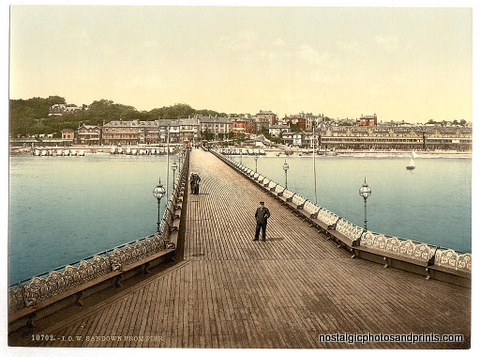
The coast has always been a recreational environment, although until the mid-nineteenth century, such recreation was a luxury only for the wealthy. Even in Roman times, the town of Baiae, by the Tyrrhenian Sea in Italy, was a resort for those who were sufficiently prosperous. During the early nineteenth century, the Prince Regent popularized Brighton, on the south coast of England, as a fashionable alternative to the wealthy spa towns such as Cheltenham. Later, Queen Victoria's long-standing patronage of the Isle of Wight and Ramsgate in Kent ensured the seaside residence was a highly fashionable possession for those wealthy enough to afford more than one home. Nowadays, many beach resorts are available as far afield as Goa in India. It was in the mid-nineteenth century that it became popular for people from less privileged classes to take holidays at seaside resorts. Improvements in transport brought about by the industrial revolution enabled people to take vacations away from home, and led to the growth of coastal towns as seaside resorts.
British seaside resorts
As the nineteenth century progressed, British working class day-trippers travelled on organized trips such as railway excursions, or by steamer, for which long piers were erected so that the ships bringing the trade could berth.
The popularization of the seaside resort during this period was nowhere more pronounced than in Blackpool. Blackpool catered for workers from across industrial Northern England, who packed its beaches and promenade. Other northern towns (for example Scarborough, Southport, Bridlington, Morecambe and Skegness) shared in the success of this new concept, especially from trade during Wakes weeks. The concept spread rapidly to other British coastal towns including several on the coast of North Wales and notably Rhyl, and Llandudno, the largest resort in Wales and known as "The Queen of the Welsh Resorts", a title first implied as early as 1864.
Some resorts, especially those more southerly such as Bournemouth and Brighton, were built as new towns or extended by local landowners to appeal to wealthier vacationers. The south coast has many seaside towns, the most being in Sussex which has the title 'Sussex by the Sea.'
From the last quarter of the twentieth century, the popularity of the British seaside resort has declined for the same reason that it first flourished: advancements in transport. The greater accessibility of foreign holiday destinations, through package holidays and, more recently, European low-cost airlines, affords people the freedom to holiday abroad. Despite the loyalty of returning holiday-makers, resorts such as Blackpool have struggled to compete against the favorable weather of Southern European alternatives. Now, many symbols of the traditional British resort (holiday camps, end-of-the-pier shows and saucy postcards) are regarded by some as drab and outdated; the skies are imagined to be overcast (although British summers from the late 1980s onwards have often been warmer and sunnier than at any other time in living memory) and the beach windswept. This is not always true; for example Broadstairs in Kent has retained much of its old world charm with Punch and Judy and donkey rides and still remains popular being only one hour from the M25.
Many seaside towns have turned to other entertainment industries, and some of them have a good deal of nightlife. The cinemas and theatres often remain to become host to a number of pubs, bars, restaurants and nightclubs. Most of their entertainment facilities cater to local people and the beaches still remain popular during the summer months. Although international tourism turned people away from British seaside towns, it also brought in foreign travel and as a result, many seaside towns offer foreign language schools, the students of which often return to vacation and sometimes to settle.
A lot of people can also afford more time off and 'second holidays' and short breaks which still attract a lot of people to British seaside towns and a lot of young people and students are able to take short holidays and to discover the town's nightlife. A lot of seaside towns boast large shopping centres which also attract people from a wide area and a lot of day trippers still come to the coastal towns but on a more local scale than during the 19th century.
A lot of coastal towns are also popular retirement hotspots and many older people take short breaks in the autumn months.
In contrast, the fortunes of Brighton, which has neither holiday camps nor end-of-the-pier shows, have grown considerably, and, because of this, the resort is repeatedly held up as the model of a modern resort. However, unlike the Golden Miles of other British resorts, the sea is not Brighton's primary attraction: rather it is a backdrop against which is set an attitude of broad-minded cosmopolitan hedonism. The resulting sense of uniqueness has, coupled with the city's proximity to London, led to Brighton's restoration as a fashionable resort and the dwelling-place of the affluent.
Other English coastal towns have successfully sought to project a sense of their unique character. In particular, Southwold on the Suffolk coast is an active yet peaceful retirement haven with an emphasis on calmness, quiet countryside and jazz. Weymouth, Dorset offers itself as 'the gateway to the Jurassic Coast', Britain's only natural World Heritage Site. Newquay in Cornwall offers itself as the 'surfing capital of Britain', hosting international surfing events on its shores.
Torbay in South Devon is known is also known as the English Riviera. Consisting of the towns of Torquay, Paignton with its pier and Brixham, the bay has 20 beaches and coves along its 22-mile (35 km) coastline, ranging from small secluded coves to the larger promenade style seafronts of Torquay's Torre Abbey Sands and Paignton Sands.
Northern Ireland has a number of seaside resorts, such as Portrush, situated on the north coast, with its two beaches and a world-famous golf course.Royal Portrush Golf Club. Other Northern Irish seaside resorts are Newcastle, located on the east coast at the foot of the Mourne Mountains, Portstewart, and Bangor. Bangor Marina is one of the largest in Ireland and the marina has on occasion been awarded the "Blue Flag" for attention to environmental issues.
http://en.wikipedia.org/wiki/Seaside_resort#History_of_the_seaside_resort
Sandown-isle of wight

The coast has always been a recreational environment, although until the mid-nineteenth century, such recreation was a luxury only for the wealthy. Even in Roman times, the town of Baiae, by the Tyrrhenian Sea in Italy, was a resort for those who were sufficiently prosperous. During the early nineteenth century, the Prince Regent popularized Brighton, on the south coast of England, as a fashionable alternative to the wealthy spa towns such as Cheltenham. Later, Queen Victoria's long-standing patronage of the Isle of Wight and Ramsgate in Kent ensured the seaside residence was a highly fashionable possession for those wealthy enough to afford more than one home. Nowadays, many beach resorts are available as far afield as Goa in India. It was in the mid-nineteenth century that it became popular for people from less privileged classes to take holidays at seaside resorts. Improvements in transport brought about by the industrial revolution enabled people to take vacations away from home, and led to the growth of coastal towns as seaside resorts.
British seaside resorts
As the nineteenth century progressed, British working class day-trippers travelled on organized trips such as railway excursions, or by steamer, for which long piers were erected so that the ships bringing the trade could berth.
The popularization of the seaside resort during this period was nowhere more pronounced than in Blackpool. Blackpool catered for workers from across industrial Northern England, who packed its beaches and promenade. Other northern towns (for example Scarborough, Southport, Bridlington, Morecambe and Skegness) shared in the success of this new concept, especially from trade during Wakes weeks. The concept spread rapidly to other British coastal towns including several on the coast of North Wales and notably Rhyl, and Llandudno, the largest resort in Wales and known as "The Queen of the Welsh Resorts", a title first implied as early as 1864.
Some resorts, especially those more southerly such as Bournemouth and Brighton, were built as new towns or extended by local landowners to appeal to wealthier vacationers. The south coast has many seaside towns, the most being in Sussex which has the title 'Sussex by the Sea.'
From the last quarter of the twentieth century, the popularity of the British seaside resort has declined for the same reason that it first flourished: advancements in transport. The greater accessibility of foreign holiday destinations, through package holidays and, more recently, European low-cost airlines, affords people the freedom to holiday abroad. Despite the loyalty of returning holiday-makers, resorts such as Blackpool have struggled to compete against the favorable weather of Southern European alternatives. Now, many symbols of the traditional British resort (holiday camps, end-of-the-pier shows and saucy postcards) are regarded by some as drab and outdated; the skies are imagined to be overcast (although British summers from the late 1980s onwards have often been warmer and sunnier than at any other time in living memory) and the beach windswept. This is not always true; for example Broadstairs in Kent has retained much of its old world charm with Punch and Judy and donkey rides and still remains popular being only one hour from the M25.
Many seaside towns have turned to other entertainment industries, and some of them have a good deal of nightlife. The cinemas and theatres often remain to become host to a number of pubs, bars, restaurants and nightclubs. Most of their entertainment facilities cater to local people and the beaches still remain popular during the summer months. Although international tourism turned people away from British seaside towns, it also brought in foreign travel and as a result, many seaside towns offer foreign language schools, the students of which often return to vacation and sometimes to settle.
A lot of people can also afford more time off and 'second holidays' and short breaks which still attract a lot of people to British seaside towns and a lot of young people and students are able to take short holidays and to discover the town's nightlife. A lot of seaside towns boast large shopping centres which also attract people from a wide area and a lot of day trippers still come to the coastal towns but on a more local scale than during the 19th century.
A lot of coastal towns are also popular retirement hotspots and many older people take short breaks in the autumn months.
In contrast, the fortunes of Brighton, which has neither holiday camps nor end-of-the-pier shows, have grown considerably, and, because of this, the resort is repeatedly held up as the model of a modern resort. However, unlike the Golden Miles of other British resorts, the sea is not Brighton's primary attraction: rather it is a backdrop against which is set an attitude of broad-minded cosmopolitan hedonism. The resulting sense of uniqueness has, coupled with the city's proximity to London, led to Brighton's restoration as a fashionable resort and the dwelling-place of the affluent.
Other English coastal towns have successfully sought to project a sense of their unique character. In particular, Southwold on the Suffolk coast is an active yet peaceful retirement haven with an emphasis on calmness, quiet countryside and jazz. Weymouth, Dorset offers itself as 'the gateway to the Jurassic Coast', Britain's only natural World Heritage Site. Newquay in Cornwall offers itself as the 'surfing capital of Britain', hosting international surfing events on its shores.
Torbay in South Devon is known is also known as the English Riviera. Consisting of the towns of Torquay, Paignton with its pier and Brixham, the bay has 20 beaches and coves along its 22-mile (35 km) coastline, ranging from small secluded coves to the larger promenade style seafronts of Torquay's Torre Abbey Sands and Paignton Sands.
Northern Ireland has a number of seaside resorts, such as Portrush, situated on the north coast, with its two beaches and a world-famous golf course.Royal Portrush Golf Club. Other Northern Irish seaside resorts are Newcastle, located on the east coast at the foot of the Mourne Mountains, Portstewart, and Bangor. Bangor Marina is one of the largest in Ireland and the marina has on occasion been awarded the "Blue Flag" for attention to environmental issues.
http://en.wikipedia.org/wiki/Seaside_resort#History_of_the_seaside_resort
Labels: sandown isle of wight
Friday 18 December 2009
Ryde
Ryde

In 1782 numerous bodies of men, women and children from HMS Royal George, which sank suddenly at Spithead, were washed ashore at Ryde. Many were buried on land that is now occupied by The Esplanade. A memorial to them was erected in June 2004.
Ryde is a British seaside town, civil parish and the most populous town and urban area on the Isle of Wight, with a population of approximately 30,000. It is situated on the north-east coast. The town grew in size as a seaside resort following the joining of the villages of Upper Ryde and Lower Ryde in the 19th century. The influence of this era is still strongly visible in the town's central and sea facing architecture.
As a resort, the town is noted for its expansive sands that occur at low tide, making its pier necessary on the wide beach for a regular passenger service. Ryde Pier is a listed structure which is the fourth longest pier in the United Kingdom, and also one of the oldest.
Ryde is noted for its carnivals. There are five throughout the year - an Arts Parade in June; Children's, Main and Illuminated processions at the end of August and a Lantern Parade in December. The Carnival at Ryde is the oldest in England. Attendance numbers have decreased in recent years, however reviews of the Carnival are made and there are hopes for better attendances in the near future.
In 2001 a London carnival group called Kinetika was brought to the island to teach carnival skills to adults and young people in community workshops. Since Kinetika's input the carnival has been expanding, with its effects felt throughout the island's other carnivals.
Ryde Carnival remains the island's largest carnival, with local crowds and mainland visitors totalling in excess of 50,000 spectators. Performers consist of community groups, schools, multiple samba and brass bands, stilt walkers and family groups, with over 2,000 performers taking part in August 2006.
http://en.wikipedia.org/wiki/Ryde

In 1782 numerous bodies of men, women and children from HMS Royal George, which sank suddenly at Spithead, were washed ashore at Ryde. Many were buried on land that is now occupied by The Esplanade. A memorial to them was erected in June 2004.
Ryde is a British seaside town, civil parish and the most populous town and urban area on the Isle of Wight, with a population of approximately 30,000. It is situated on the north-east coast. The town grew in size as a seaside resort following the joining of the villages of Upper Ryde and Lower Ryde in the 19th century. The influence of this era is still strongly visible in the town's central and sea facing architecture.
As a resort, the town is noted for its expansive sands that occur at low tide, making its pier necessary on the wide beach for a regular passenger service. Ryde Pier is a listed structure which is the fourth longest pier in the United Kingdom, and also one of the oldest.
Ryde is noted for its carnivals. There are five throughout the year - an Arts Parade in June; Children's, Main and Illuminated processions at the end of August and a Lantern Parade in December. The Carnival at Ryde is the oldest in England. Attendance numbers have decreased in recent years, however reviews of the Carnival are made and there are hopes for better attendances in the near future.
In 2001 a London carnival group called Kinetika was brought to the island to teach carnival skills to adults and young people in community workshops. Since Kinetika's input the carnival has been expanding, with its effects felt throughout the island's other carnivals.
Ryde Carnival remains the island's largest carnival, with local crowds and mainland visitors totalling in excess of 50,000 spectators. Performers consist of community groups, schools, multiple samba and brass bands, stilt walkers and family groups, with over 2,000 performers taking part in August 2006.
http://en.wikipedia.org/wiki/Ryde
Paignton
Paignton

Paignton is mentioned in records dating back to the Domesday Book of 1086 AD. Formerly spelled both as Peynton and Paington, the name has is derived from Paega's town, the original Celtic settlement.
Paignton was a small fishing village until the 19th century, when in 1837 the Paington Harbour Act led to the construction of a new harbour. It was around this time that the modern spelling of Paignton first appeared. The historic part of Paignton is centred around Church Street, Winner Street and Palace Avenue which contains fine examples of Victorian architecture. Kirkham House is a late medieval stone house in the town which is open to the public at certain times of year. The Coverdale Tower is adjacent to Paignton Parish Church and is named after Bishop Miles Coverdale, who published an English translation of the Bible in 1536. Coverdale was Bishop of Exeter between 1551 and 1553 and is said to have lived in the tower during this period, although this is regarded as doubtful by modern historians.
Oldway Mansion was built for Isaac Merritt SingerThe railway line to Paignton was built by the Dartmouth and Torbay Railway, and was opened to passengers on 2 August 1859, thus providing Torquay and Paignton a link to London. The people of Paignton acquired the nickname of pudden eaters when thousands turned up hoping to obtain a piece of a huge pudding that had been baked to celebrate the arrival of the railway. A Paignton Pudding was baked in 1968 to celebrate the town's charter, and another was baked in 2006 to mark the 200th anniversary of the birth of the engineer Isambard Kingdom Brunel.
Oldway Mansion is a large house and gardens in Paignton constructed in the 1870s for Isaac Merritt Singer, who had amassed a considerable fortune by dint of his improvements to the sewing machine. The building is now occupied by Torbay Council. Other Singer legacies in Paignton include the Palace Hotel and the Inn On The Green, which were built as homes for Singer's sons Washington and Mortimer respectively.
As Paignton's population grew, it merged with the coastal villages of Goodrington and Preston. The town had its own urban district council until 1968, when the creation of Torbay Council led to a single body covering Torquay, Paignton and Brixham. The unitary authority formed in 1998 now handles all local government for Torbay, which has its own directly elected mayor.
http://en.wikipedia.org/wiki/Paignton

Paignton is mentioned in records dating back to the Domesday Book of 1086 AD. Formerly spelled both as Peynton and Paington, the name has is derived from Paega's town, the original Celtic settlement.
Paignton was a small fishing village until the 19th century, when in 1837 the Paington Harbour Act led to the construction of a new harbour. It was around this time that the modern spelling of Paignton first appeared. The historic part of Paignton is centred around Church Street, Winner Street and Palace Avenue which contains fine examples of Victorian architecture. Kirkham House is a late medieval stone house in the town which is open to the public at certain times of year. The Coverdale Tower is adjacent to Paignton Parish Church and is named after Bishop Miles Coverdale, who published an English translation of the Bible in 1536. Coverdale was Bishop of Exeter between 1551 and 1553 and is said to have lived in the tower during this period, although this is regarded as doubtful by modern historians.
Oldway Mansion was built for Isaac Merritt SingerThe railway line to Paignton was built by the Dartmouth and Torbay Railway, and was opened to passengers on 2 August 1859, thus providing Torquay and Paignton a link to London. The people of Paignton acquired the nickname of pudden eaters when thousands turned up hoping to obtain a piece of a huge pudding that had been baked to celebrate the arrival of the railway. A Paignton Pudding was baked in 1968 to celebrate the town's charter, and another was baked in 2006 to mark the 200th anniversary of the birth of the engineer Isambard Kingdom Brunel.
Oldway Mansion is a large house and gardens in Paignton constructed in the 1870s for Isaac Merritt Singer, who had amassed a considerable fortune by dint of his improvements to the sewing machine. The building is now occupied by Torbay Council. Other Singer legacies in Paignton include the Palace Hotel and the Inn On The Green, which were built as homes for Singer's sons Washington and Mortimer respectively.
As Paignton's population grew, it merged with the coastal villages of Goodrington and Preston. The town had its own urban district council until 1968, when the creation of Torbay Council led to a single body covering Torquay, Paignton and Brixham. The unitary authority formed in 1998 now handles all local government for Torbay, which has its own directly elected mayor.
http://en.wikipedia.org/wiki/Paignton
Dover
Dover
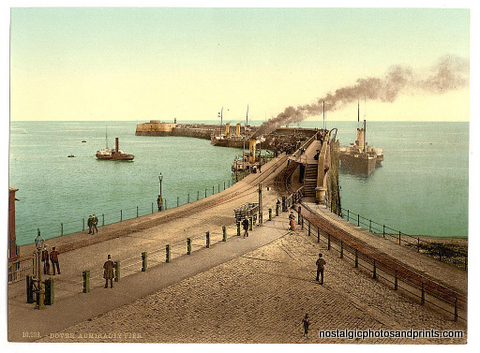
Dover’s name originated with its river - the River Dour, deriving from the Brythonic Dubrās ("the waters"), via its Latinized form of Dubris. The cliffs also gave Britain its ancient name of Albion ("white"). The Romans called it ’’Porte Dubris’’; the modern name was in use at least by the time Shakespeare wrote 'King Lear' (between 1603 and 1606), in which the town and its cliffs play a prominent role.
Dover’s history, because of its proximity to France, has always been of great strategic importance to Britain. Archaeological finds have shown that there were Stone Age people in the area; and that by the Bronze Age the maritime influence was already strong. Some Iron Age finds exist also, but the coming of the Romans made Dover part of their communications network. Like Lemanis (Lympne) and Rutupiae (Richborough) Dover was connected by road to Canterbury and Watling Street; and it became Portus Dubris, a fortified port. Forts were built above the port; lighthouses were constructed to guide ships; and one of the best-preserved Roman villas in Britain is here.
Dover figured largely in the Domesday Book as an important borough. It also served as a bastion against various attackers: notably the French during the Napoleonic Wars; and against Germany during World War II.
http://en.wikipedia.org/wiki/Dover

Dover’s name originated with its river - the River Dour, deriving from the Brythonic Dubrās ("the waters"), via its Latinized form of Dubris. The cliffs also gave Britain its ancient name of Albion ("white"). The Romans called it ’’Porte Dubris’’; the modern name was in use at least by the time Shakespeare wrote 'King Lear' (between 1603 and 1606), in which the town and its cliffs play a prominent role.
Dover’s history, because of its proximity to France, has always been of great strategic importance to Britain. Archaeological finds have shown that there were Stone Age people in the area; and that by the Bronze Age the maritime influence was already strong. Some Iron Age finds exist also, but the coming of the Romans made Dover part of their communications network. Like Lemanis (Lympne) and Rutupiae (Richborough) Dover was connected by road to Canterbury and Watling Street; and it became Portus Dubris, a fortified port. Forts were built above the port; lighthouses were constructed to guide ships; and one of the best-preserved Roman villas in Britain is here.
Dover figured largely in the Domesday Book as an important borough. It also served as a bastion against various attackers: notably the French during the Napoleonic Wars; and against Germany during World War II.
http://en.wikipedia.org/wiki/Dover
Ramsgate
Ramsgate
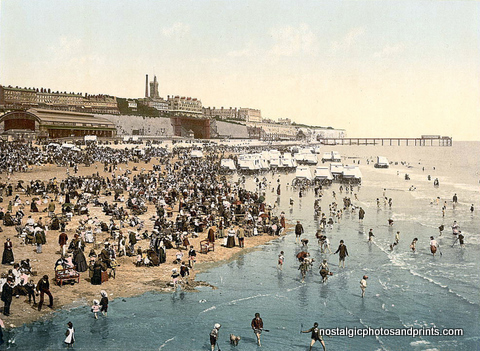
Ramsgate began as a fishing and farming hamlet. Ramsgate as a name has its earliest reference as Hraefn's ate, or cliff gap, later to be rendered 'Ramisgate' or 'Remmesgate' around 1225 and 'Ramesgate' from 1357. The legendary mercenaries Hengest and Horsa landed in the 5th century to herald the pagan Anglo-Saxon age in England. The Christian missionary St. Augustine landed in Ramsgate in 597 which re-established the link between England and the Christian church in Rome.
Ramsgate's harbour is a defining characteristic of the town. The construction of Ramsgate Harbour began in 1749 and was completed in about 1850. The Harbour has the unique distinction of being the only Royal Harbour in the United Kingdom. Because of its proximity to mainland Europe, Ramsgate was a chief embarkation point both during the Napoleonic Wars and for the Dunkirk evacuation in 1940.
Ramsgate Sands in 1854In 1901, the Isle of Thanet saw the introduction of an electric tram service which was one of the few inter-urban tramways in Britain. The towns of Ramsgate, Margate and Broadstairs were linked by 11 miles of track.
In 1915-1916 early aircraft began to use the open farmlands at Manston as a site for emergency landings. The location near the Kent coast gave Manston some advantages over the other previously established aerodromes. By 1917 the Royal Flying Corps was well established and taking an active part in the defence of England. As RAF Manston the aerodrome played an important role in the second World War and is now called Kent International Airport.
http://en.wikipedia.org/wiki/Ramsgate

Ramsgate began as a fishing and farming hamlet. Ramsgate as a name has its earliest reference as Hraefn's ate, or cliff gap, later to be rendered 'Ramisgate' or 'Remmesgate' around 1225 and 'Ramesgate' from 1357. The legendary mercenaries Hengest and Horsa landed in the 5th century to herald the pagan Anglo-Saxon age in England. The Christian missionary St. Augustine landed in Ramsgate in 597 which re-established the link between England and the Christian church in Rome.
Ramsgate's harbour is a defining characteristic of the town. The construction of Ramsgate Harbour began in 1749 and was completed in about 1850. The Harbour has the unique distinction of being the only Royal Harbour in the United Kingdom. Because of its proximity to mainland Europe, Ramsgate was a chief embarkation point both during the Napoleonic Wars and for the Dunkirk evacuation in 1940.
Ramsgate Sands in 1854In 1901, the Isle of Thanet saw the introduction of an electric tram service which was one of the few inter-urban tramways in Britain. The towns of Ramsgate, Margate and Broadstairs were linked by 11 miles of track.
In 1915-1916 early aircraft began to use the open farmlands at Manston as a site for emergency landings. The location near the Kent coast gave Manston some advantages over the other previously established aerodromes. By 1917 the Royal Flying Corps was well established and taking an active part in the defence of England. As RAF Manston the aerodrome played an important role in the second World War and is now called Kent International Airport.
http://en.wikipedia.org/wiki/Ramsgate
Dawlish

The people who first settled in Dawlish lived on the higher grounds. These were fishermen and salt makers who would venture down to the coast to net fish and gather salt. Salt was abundant in rock pools at the time but resources would have been limited. So eventually salterns were constructed to dry out brine and produce salt. The high-quality salt produced was stored in sheds or saltcellars. Dawlish produced less salt than its neighbour Teignmouth, most likely due to inhabitants being wary of Dawlish water and its unpredictability when it came to flooding.
The town of Dawlish took its name from a local stream with a Brythonic name, once spelt 'Deawlisc', meaning 'Devil Water' (the name came from heavy rains churning up the red cliffs, making the brook run red). An alternative meaning proposed is 'black stream', cognate with Welsh du (g)lais. Several other spellings and meanings are found later in the Domesday Book and in documents from Exeter Cathedral.
Salt making would have started before Roman times (55 BC) and continued until the withdrawal of the Romans in 400 AD. Sometime during the Anglo-Saxon period (400 AD - 1000 AD) salt making in Dawlish ceased, however Teignmouth continued its production. During the Anglo-Saxon period the number of inhabitants grew and some communities settled in the upper part of the valley where floods were less common and the land was fertile. Evidence of early farming settlements is found at Aller Farm, Smallacombe, Lidewell and Higher and Lower Southwood.
When the Romans invaded Britain, the Celtic population of Devon was not displaced and continued to occupy the land throughout the Roman period that lasted until the Anglo-Saxons arrived. The Anglo-Saxons conquered Devon and it was annexed by the kingdom of Wessex in the 8th century. Since then the local culture has been predominantly English.
The Danish invasion of 800 AD left Dawlish untouched, possibly due to the shallow sea waters and marshland. Bishopsteignton was destroyed by the Danes in 1001 AD along with settlements at the mouth of the River Teign.
Until its sale in the 19th century, the site of Dawlish belonged to Exeter Cathedral, having been given to the chapter by Leofric, Bishop of Exeter in 1050
Dawlish, was once the haunt of such literary giants as Charles Dickens and Jane Austen. Charles Dickens used the town as the birthplace of Nicholas Nickleby. The town itself, particularly around the seafront, is like many of the resort towns in South Devon, a classic of Regency and early Victorian style. Also worth noting are Manor House and Brook House (both about 1800) and some of the cottages in Old Town Street surviving from the old Dawlish village. Dawlish's transformation from an insignificant fishing settlement to a watering hole for Victorian celebrities can be discovered at the excellent Museum.
http://en.wikipedia.org/wiki/Dawlish
Labels: old photos
Welcome
Hi,welcome to my blog-British seaside resorts, a collection of photographs and monochromes dating from 1900 Britain.
Labels: british seaside resorts, nostalgic photography
Subscribe to Posts [Atom]

